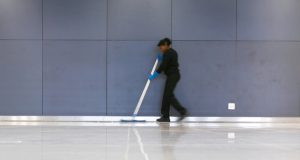In a home habitat, mobile workers don’t necessarily need their own desk, but when they are in the office they need a place to perform individual work. Typically, we may work away from the office one or two days a week and spend the rest of the week hotdesking and utilising cloud-based services to conduct our work. Sharing a desk means sharing a chair, and many facilities managers are turning to the latest generation of task chairs that don’t require any adjustments other than seat height. With no complex assembly, or complicated multiple options, there’s no need for training.
Such chairs provide dynamic support through fluid movement, and are ideal for modern offices where seating no longer belongs to just one person. They provide a better fit for a broad range of user shapes and sizes, enabling multiple people to use the same chair throughout the course of the day. The absence of a lockable backrest encourages users to remain dynamic, avoiding static postures – the primary cause of musculoskeletal stress. They can be specified for different areas of the office, including boardrooms and meeting areas.
The home habitat also provides touchdown or breakout facilities equipped with relevant tools and technology. This environment provides an ergonomically sound alternative to sitting at a desk or a table, with flexible furniture allowing for standalone or grouped working. This arrangement is ideal for nomadic workers armed with laptops, tablets and mobile phones, enabling them to work anywhere. High-backed meeting booths and standalone personal high-back seating solutions are ideal for breaking up large, open-plan spaces. While their primary purpose is to serve head-down focused work, they also support one-on-one collaboration.
While workplaces are trending towards open and flexible environments, it’s important to remember the need for peace and privacy within the home habitat. Personal workspace solutions are strongly linked to an increase in employee creativity, productivity and wellbeing. Promoting individual focused work, they offer peace and quiet away from office distractions. Look out for models that offer enhanced privacy screens, power and data supply for connectivity, and writing tables complete with articulated arms.
PROMOTING COLLABORATION
As communication and collaboration continue to be the key driving forces behind the design of seating and furniture in the workplace today, workstations are becoming smaller to enable larger common spaces. Soft office seating has grown to accommodate this trend. Unassigned touchdown spaces, which may be open or enclosed, offer a modicum of visual and acoustic privacy and the ability to support both team and one-on-one meetings. To further aid collaboration, it’s important that vertical surfaces feature throughout the workplace. From standalone media walls with TV, video and online facilities, or a fixed whiteboard, a variety of technological functions should be made available.
 There’s also a growing trend towards freestanding glass-fronted meeting pods that promote the flow of nomadic working patterns and teamwork. Whether accommodating a small group or a larger team, they offer the intimacy and privacy vital for today’s ways of working and are extremely conducive to wellbeing. Some pods even feature a human-centric lighting system that adjusts the colour and intensity of white light in accordance with people’s natural circadian rhythms, improving concentration, safety and efficiency.
There’s also a growing trend towards freestanding glass-fronted meeting pods that promote the flow of nomadic working patterns and teamwork. Whether accommodating a small group or a larger team, they offer the intimacy and privacy vital for today’s ways of working and are extremely conducive to wellbeing. Some pods even feature a human-centric lighting system that adjusts the colour and intensity of white light in accordance with people’s natural circadian rhythms, improving concentration, safety and efficiency.
Meanwhile, cafés and coffee bars allow employees from every department to intermingle, acting as breeding grounds for fresh ideas. They, too, are conducive to wellbeing as people tend to relax more in this type of environment – especially when available throughout the working day, not just at dedicated break times. The space is a compelling way to generate energy and should offer a mix of soft seating and booths to support and encourage collaboration, not just tables and chairs.
For wellbeing to truly flourish in the workplace, we need environments that foster creativity, collaboration, innovation, and thoughtfulness. By successfully creating habitats, not only will we feel more comfortable, we will view the workplace as an environment where we can be at the top of our game. Equally, by furnishing these spaces with flexible and ergonomic furniture, our wellbeing and productivity will soar.




